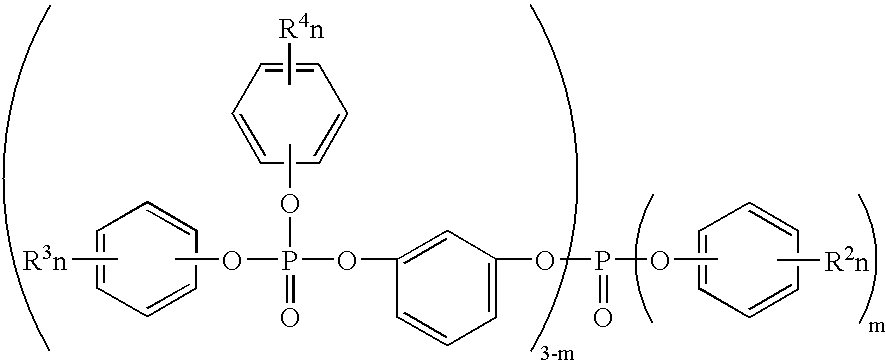Thermosetting resin composition, and prepreg, laminated board for wiring board and printed wiring board using the same
a technology of thermosetting resin and resin composition, which is applied in the direction of synthetic resin layered products, textiles and paper, woven fabrics, etc., can solve the problems of not showing toughness, toxicity and carcinogenicity of organic halogen substances such as dioxin in particular, and the occurrence of considerable warping, etc., to achieve high heat resistance, low dispersion factor, and high modulus of elasticity
- Summary
- Abstract
- Description
- Claims
- Application Information
AI Technical Summary
Benefits of technology
Problems solved by technology
Method used
Image
Examples
synthesis example 1
(A-1) Synthesis of Thermosetting Resin Comprising a Dihydrobenzoxazine Ring as a Main Component
[0048] To a 5 liter volume flask equipped with a thermometer, stirrer, condenser tube and dropping device were added 1000 g of bisphenol F and 920 g of methanol, and the mixture was dissolved at 50° C. while stirring. 652 g of paraformaldehyde were then added to the solution. Moreover, 930 g of aniline were added dropwise over one hour while stirring, and one hour later, the temperature was raised to 78 to 80° C. After allowing to react for 7 hours while refluxing, the pressure was reduced and the mixture was concentrated under reduced pressure at a pressure of 360 mmHg. Concentration was continued while maintaining this vacuum degree, and the vacuum degree was increased to 90 mmHg when the temperature of the resin reached 110° C. After confirming that there was no more outflow of liquid, the resin was taken out into a vat to produce a thermosetting resin (A1) comprising a dihydrobenzoxa...
synthesis example 2
(A-2) Synthesis of Thermosetting Resin Comprising a Dihydrobenzoxazine Ring as a Main Component
[0049] The above thermosetting resin (A1) comprising a dihydrobenzoxazine ring as a main component was heated for 6 hours at 110° C. under normal pressure to produce a thermosetting resin (A2) comprising a dihydrobenzoxazine ring as a main component and having a softening point of the resin being 110° C.
synthesis example 3
(a-3 and 4) Synthesis of Thermosetting Resins Comprising a Dihydrobenzoxazine Ring as their Main Component
[0050] (1) Synthesis of Phenol Novolak
[0051] Into a 5 liter volume flask were charged 1.9 kg of phenol, 1.15 kg of formalin (37% aqueous solution) and 4 g of oxalic acid and the mixture was allowed to react for 6 hours at the reflux temperature. Subsequently, the inside of the flask was reduced to a pressure of 6666.1 Pa or lower to remove the unreacted phenol and water. The resulting resin had a softening point of 89° C. (the ring and ball method), and the ratio of {(3 core form+3 or more core form) / (2 core form)} was 89 / 11 (from peak area ratio as determined by gel permeation chromatography). The core form here refers to the phenol group portion.
[0052] (2) Introduction of Dihydrobenzoxazine Ring
[0053] 1.7 kg of the phenol novolak resin synthesized as described above (equivalent to 16 mols of hydroxyl groups) were stirred for 5 hours at 80° C. with 1.49 kg (equivalent to 1...
PUM
| Property | Measurement | Unit |
|---|---|---|
| softening point | aaaaa | aaaaa |
| mean particle diameter | aaaaa | aaaaa |
| temperature | aaaaa | aaaaa |
Abstract
Description
Claims
Application Information
 Login to View More
Login to View More - R&D
- Intellectual Property
- Life Sciences
- Materials
- Tech Scout
- Unparalleled Data Quality
- Higher Quality Content
- 60% Fewer Hallucinations
Browse by: Latest US Patents, China's latest patents, Technical Efficacy Thesaurus, Application Domain, Technology Topic, Popular Technical Reports.
© 2025 PatSnap. All rights reserved.Legal|Privacy policy|Modern Slavery Act Transparency Statement|Sitemap|About US| Contact US: help@patsnap.com


